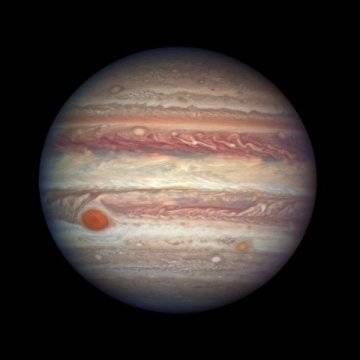 Close Topic Options
Close Topic OptionsJupiter - Page 2 of 6
Good question KN. We could use these gas giants - Page 2 - Sciences, Education, Art, Writing, UFO - Posted: 7th Apr, 2017 - 9:03pm
Jupiter - Page 2
New radio map of Jupiter reveals what's beneath colorful clouds
Using the upgraded Very Large Array, astronomers have produced a detailed radio map of the upper 100 kilometers of Jupiter's atmosphere, revealing the complex movement of ammonia gas that shapes the colorful clouds observed in the optical. The map will help understand how global circulation and cloud formation are driven by Jupiter's powerful internal heat source, and shed light on similar processes on giant planets in our solar system and around distant stars. Ref. Source 4n.
Jupiter
Juno spacecraft and its July 4th arrival at Jupiter
The solar-powered spacecraft will perform a suspenseful Jupiter orbit insertion maneuver -- a 35-minute burn of its main engine -- which will slow Juno by about 1,200 mph (542 meters per second) so it can be captured into the gas giant’s polar orbit. Juno will loop Jupiter 37 times during 20 months, skimming to within 3,100 miles (5,000 kilometers) above its swirling cloud tops. Ref. Source 5z.
Jupiter UFO & Writing Art Education Sciences
NASA's Juno Spacecraft in Orbit Around Mighty Jupiter
After an almost five-year journey to the solar system’s largest planet, NASA's Juno spacecraft successfully entered Jupiter’s orbit during a 35-minute engine burn. Confirmation that the burn had completed was received on Earth at 8:53 p.m. PDT (11:53 p.m. EDT) Monday, July 4.
“Independence Day always is something to celebrate, but today we can add to America’s birthday another reason to cheer -- Juno is at Jupiter,” said NASA Ref. Source 5x.
Page 2 Jupiter
Jupiter's north pole unlike anything encountered in solar system
NASA's Juno spacecraft has sent back the first-ever images of Jupiter's north pole, taken during the spacecraft's first flyby of the planet with its instruments switched on. The images show storm systems and weather activity unlike anything previously seen on any of our solar system's gas-giant planets. Ref. Source 8j.
Jupiter - Page 2
With Jupiter being a large gas planet I do wonder what gasses we would be able to harvest off this planet as we make the transition into being space faring people. We have some technology to allow us move around in the solar system we just need to improve upon it. I think that Jupiter can be a key.
 TOPIC: Jupiter
TOPIC: Jupiter
